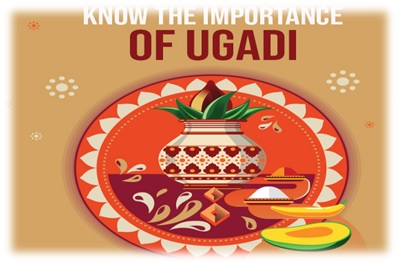
-By Urban dsouza,
M.A; B.Ed; diploma in Journalism,
Executive MBA
 The word Ugadi is derived from two different words; ‘Yuga’ that means ‘age’ in Sanskrit and ‘Adi’ that means ‘beginning in both Sanskrit and Kannada. This festival celebrates the New Year in Karnatake. This day is also known as Chandramana Ugadi and refers to the beginning of the New Year according to the Hindu Lunar calendar that usually falls in the months of March and April (as per the Gregorian calendar). This auspicious day involves religious observances and customers. It is customary for people to shop heavily during the months preceding Chaitra (the first month in the Hindu calendar).This day is celebrated with fervor and is also regarded as the herald of the harvest season.
The word Ugadi is derived from two different words; ‘Yuga’ that means ‘age’ in Sanskrit and ‘Adi’ that means ‘beginning in both Sanskrit and Kannada. This festival celebrates the New Year in Karnatake. This day is also known as Chandramana Ugadi and refers to the beginning of the New Year according to the Hindu Lunar calendar that usually falls in the months of March and April (as per the Gregorian calendar). This auspicious day involves religious observances and customers. It is customary for people to shop heavily during the months preceding Chaitra (the first month in the Hindu calendar).This day is celebrated with fervor and is also regarded as the herald of the harvest season.
Background
Among the few legends associated with Ugadi, there is one pertaining to Brahma that is
widely popular. It is believed that Lord Brahma began creating the world on this day and Ugadi refers specifically to the Yuga in which the current generation lives i.e. the Kalyug. It is also referred to as Chaitra Suddha Paadyami according to Hindu religious texts.
Ugadi also coincides with the onset of spring and the harvest season. This day is also considered highly auspicious to start new ventures. However, all business transactions are carried out after certain religious observances that are said to bring good luck, wealth and prosperity to believers.
The Celebration
Before the beginning of Chaitra, people clean and whitewash their homes and decorate temples as well as the deity rooms in their homes with jasmine flowers and mango leaves.To start the celebrations, the entire household wakes up before dawn and take a head bath after massaging the whole body with sesame oil and wear new, traditional clothes. The idols of gods and goddesses within the house are then bathed in oil too, after which prayers and offerings of neem flowers, mango and tamarind are given up. The elderly women in the family then apply oil and vermilion to the forehead of the younger members following which all members of the family watch their reflection in a vessel of molten ghee.
 The entire family worships the Panchanga or the new Hindu almanac which is read for the first time. It is believed that special blessings are bestowed on those who read and listen to the Panchanga. The temple priest or whosoever is reading the Panchanga needs to be given gifts of thanks in the form of new clothes.
The entire family worships the Panchanga or the new Hindu almanac which is read for the first time. It is believed that special blessings are bestowed on those who read and listen to the Panchanga. The temple priest or whosoever is reading the Panchanga needs to be given gifts of thanks in the form of new clothes.
There is a special type of food item that is prepared for this occasion and is called the Bevu Bella. The preparation is a mix of Neem flowers or buds, jaggery, green chilies, salt,
tamarind juice and un-ripened mango that symbolizes the mixture of happy, sad, infuriating, fearful, disgusting and surprising events in life.
Ugadi & Season Change
This festival, Ugadi also welcomes the season of Spring. We see the symbols and colors of spring in nature. Ugadi celebration forges with great enthusiasm and this boosts people to accept newness of life.
During Ugadi, garlands of mango leaves & jasmine flowers are used. The decoration of the entrance of the house is done with these garlands. This is the season of jasmine and mango. And that’s why you see the use of jasmine and mango in Ugadi which is also a symbol of well-being. Moreover, jasmine heals the mind while the fragrance of fresh neem and mango heals airborne diseases.
 The Special Ugadi Food & Its Significance
The Special Ugadi Food & Its Significance
Out of all the special dishes like pulihora, bobbatlu, or New Year burelu, Ugadi Pacchadi is the most important one. This is a chutney that consists of all the five tastes or flavors – sour, bitter, sweet, salty, and tangy. The ingredients of this dish are neem flowers, tamarind paste, jaggery or brown sugar, salt, chili powder, and mango.
Ugadi Pacchadi contains all the major tastes and thus it symbolizes the fact that life is a mixture of all these tastes. Salt represents “interests in life” while sweet or jaggery represents “happiness”. Tamarind or sour taste symbolizes “challenges” while neem flowers or bitter taste symbolizes “difficulties in life. Raw mango or tangy taste refers to “surprises or sudden challenges” while chili powder or spicy taste refers to “angry moments” in one’s life. Meals are first offered to the gods before the family eats them. The rest of the day is spent in visiting temples, offering prayers and celebrating with family and friends.
The “Indra Dhwaja”, which is meant to bring in rain, Is worshiped which is also a feature of Gudi Padwa, Maharashtra’s New Year. Devotees decorate their front door with red earth and a string of mango and neem leaves. The entrance is also decorated with Rangoli in white chalk although colored powder can also be used to fill the outlined figure.
WISH YOU ALL HAPPY “UGADI”
